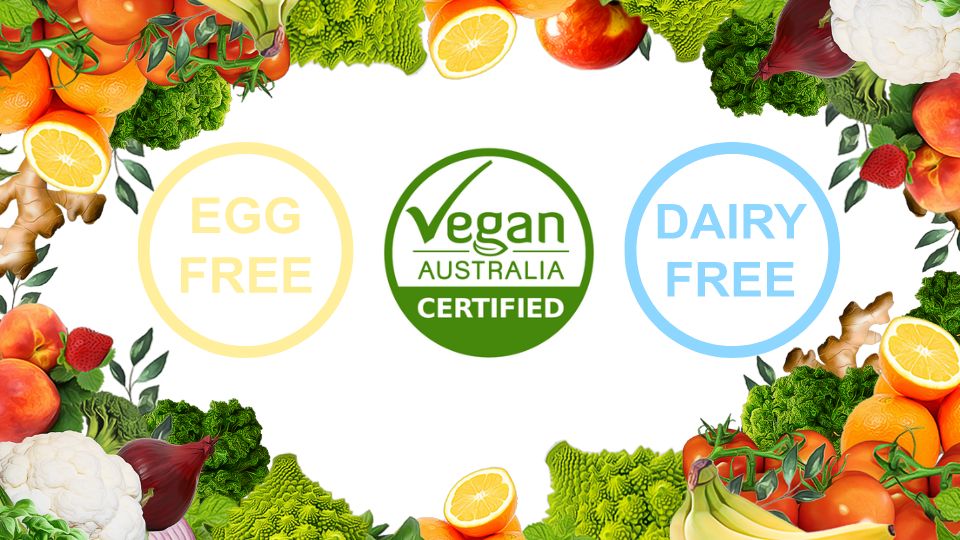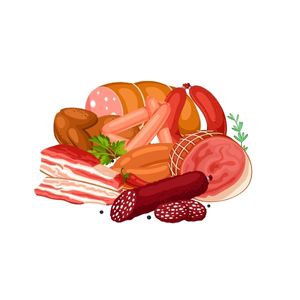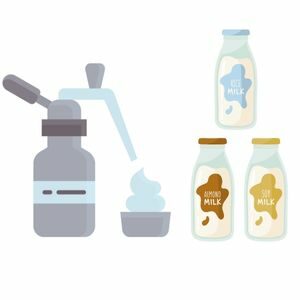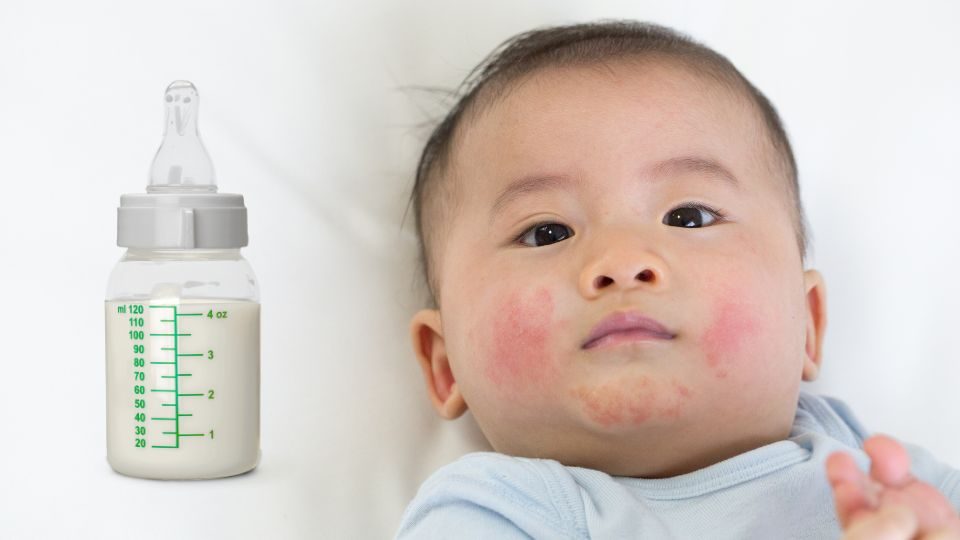The immune system’s reaction to one or more milk proteins causes a milk allergy. Milk allergy symptoms can range from very mild to life-threatening. Common symptoms are:
- Hives, eczema and itching – examples of unwanted skin reactions
- Symptoms related to the digestive system, such as nausea, bloating or constipation
- Wheezing, stuffy nose and other breathing problems
- Anaphylaxis – a potentially fatal allergic reaction
Is Vegan Food Always Free Of Dairy And Eggs?
Vegan food does not contain animal products, including meat, dairy products, or eggs. This indicates that vegan food is always free of dairy derived from mammals such as cows, goats, sheep, and eggs derived from hens.
However, some processed foods can hold the label “vegan,” even though they may contain trace amounts of dairy or eggs among their ingredients. It is vital to check the labels for ingredients and for vegan certifications to know if a product is vegan. It is crucial to read the contents list when purchasing products that claim to be vegan, such as plant-based milk, meat, etc.
Another issue with vegan meals is the potential for cross-contamination. There are a lot of processed foods that don’t necessarily contain any animal products. Still, they can be made in the same facility as dairy or eggs. In light of this, you should also look for the phrases “dairy-free” or “egg-free” in addition to the word “vegan” on product labels.
In a nutshell, vegan food does not include any goods derived from animals and does not exclude dairy or eggs. However, in reality, there is a potential for cross-contamination or additives like casein etc., with processed meals. Thus it is vital to examine the ingredient list and certifications to be sure a food is genuinely vegan.

What Does The Australian Vegan Logo Certify?
When you see the Vegan Australia Certified logo on a product, you can be sure that it satisfies the rigorous criteria for vegan products established by Vegan Australia. These criteria include:- Being free of animal products
- Not having been tested on animals, and
- Not having any animal products used in the manufacturing process
Suppose the item was manufactured in a facility that also processes animal products. In that case, the maker will have taken all precautions possible to prevent the product from becoming contaminated with animal proteins.
Cow’s Milk And Egg Allergy
Cow’s milk and egg allergies are both common food allergies; however, they differ in several ways:
| Cow’s Milk Allergy | Egg Allergy | |
| Prevalence | More Common | Less Common |
| Allergens | Milk Proteins | Egg Proteins |
| Symptoms | Hives, eczema, stomach upset, vomiting, difficulty breathing | Hives, eczema, stomach upset, vomiting, difficulty breathing |
| Cross-Reactivity | Yes | Yes |
| Outgrowing the allergy | Possible | Possible |
| Products to avoid | Dairy products, hidden sources of cow’s milk proteins | Egg-containing products, hidden sources of egg proteins |
It is crucial to note that the above table is only a basic guideline; each person’s reaction to cow’s milk and egg may vary. To discover if you can tolerate cow’s milk or eggs, it’s always better to contact a healthcare professional for accurate diagnosis and treatment and complete a strict elimination diet or food challenge test supervised by an allergy.
What Are The Symptoms Of Cows Milk Allergy in Adults?
Over two per cent of infants in Australia and New Zealand suffer from an allergy to cow’s milk. There is a spectrum of severity associated with allergic reactions. After consuming cow’s milk, quick-onset allergy reactions often manifest within 15 minutes. Still, they can sometimes last for up to two hours.
- Symptoms ranging from mild to moderate include swelling of the lips, face, and eyes, hives or welts on the skin, stomach (abdominal) pain, and vomiting.
- Cow’s milk can cause severe allergic responses, known medically as anaphylaxis, which can be potentially fatal.
- Symptoms of anaphylaxis include difficult or noisy breathing, wheezing or a persistent cough, and swelling or tightness in the throat. In small children, they may appear pale and flaccid.
- In most cases, delayed allergy reactions don’t manifest themselves until at least two hours after ingesting cow’s milk.
- This could result in several symptoms, including an increase in eczema (rashes), delayed vomiting, and diarrhoea; however, anaphylaxis is not one of these symptoms.
Not all reactions to cow’s milk can be traced back to an allergy to the protein in cow’s milk. Lactose intolerance, on the other hand, does not result in hives or anaphylaxis but can still produce reactions in certain people.
Some individuals who are allergic to cow’s milk may be able to accept cow’s milk that has been baked or cooked, such as in muffins, cakes, or biscuits. It would help if you discussed this with your clinical immunology or allergy specialist.
Cow’s Milk Allergy Foods To Avoid
If you have a milk allergy, avoid foods that include milk or its derivatives. People with a milk allergy should avoid all types of milk, including whole, skimmed, and low-fat milk.

Dairy products containing milk, such as cheese, butter, yoghurt, ice cream and sour cream, should be avoided. Avoid foods that contain milk, such as pastries, pancakes, waffles, and cereal.

Avoid processed foods that contain milk proteins, such as deli meats, sausages, and canned soups. Avoid margarine, which may contain milk protein ingredients.

Non-dairy products such as creamer, coffee bleach and whipped toppings should be avoided because they may contain milk protein. Certain brands of soy, rice, and almond milk should be avoided because they may be cross-contaminated with milk proteins during processing.

Avoid medications and supplements that may contain milk protein ingredients.
What Protein And Components In Cow’s Milk Can Trigger An Allergic Reaction
Cow’s milk contains several proteins and other components that can trigger an allergic reaction in sensitive people. The two main proteins in cow’s milk responsible for most allergic reactions are:- Casein is a phosphoprotein that makes up about 80% of the protein in cow’s milk. It is used in many processed foods, including cheese, ice cream, and infant formula.
- Whey protein makes up about 20% of the protein in cow’s milk. It is frequently used as a dietary supplement since it is easily digested and absorbed by the body.
In addition to the two primary proteins, cow’s milk also contains several other proteins, some of which are known to trigger an allergic reaction in hypersensitive individuals. These proteins are as follows:
- The beta-lactoglobulin in cow’s milk is structurally identical to the proteins in human milk that cause allergic responses. Some people allergic to it develop severe reactions, including hives and anaphylaxis.
- Alpha-lactalbumin is a protein in cow’s milk that shares structural similarities with lactoglobulin. Although it causes fewer allergic reactions than casein and whey, it is still considered a serious allergen.
- Serum albumin is a protein in cow’s milk and has structural similarities to human blood proteins. While it is an allergy, the amount in cow’s milk is low enough that most people can drink it without adverse reactions.
- Immunoglobulins are a type of protein that is an essential component of the immune system. There is a trace amount of immunoglobulins in cow’s milk. Although they can trigger allergic reactions in certain people, they are not typically considered major allergens.
People’s reactions to milk can vary depending on where it comes from since the proteins it contains can vary depending on the breed of cow or even the individual cow.
It’s worth noting that the reaction caused by these components can vary from person to person, and some may have multiple allergic reactions to different components simultaneously. Also, some people may develop tolerance to some of these proteins after a while, which can change the course of the reaction.
See an allergist for diagnosis and treatment recommendations if you suspect you have a cow’s milk allergy. They can perform skin prick tests, blood tests, or elimination diets to determine which components of cow’s milk you’re allergic to and develop a treatment plan accordingly.
Is It Possible To Be Allergic To Cow’s Milk And Not Other Forms Of Milk?
Some people may be sensitive to cow’s milk but not other forms, such as goat’s milk, sheep’s milk, or human milk. Here’s a quick run-down of why it’s possible to react only to cow milk and not other varieties:- Even though cow, goat, sheep, and human milk come from mammals, their proteins and components differ. For that reason, someone may be allergic or intolerant to particular elements in cow milk but not other kinds.
- A few individuals may be sensitive to proteins like casein and whey, but not others such as alpha-lactalbumin and beta-lactoglobulin.
- A person may have a minor reaction to certain proteins or components in cow milk but not other kinds or even a major reaction to certain proteins or components.
- Some people with lactose sensitivity may be able to drink goat’s or sheep’s milk instead of cow’s milk because these alternatives have lower lactose content.
- It’s also possible that someone’s past health history or genetics may cause them to be prone to an allergy to cow milk, but not other kinds.
Milk allergies and lactose intolerance are different, and how you handle them differs. So, it’s best to go to a doctor, diagnose the issue, and get the right treatment.
When Does An Allergy To Cow’s Milk Begin?
Milk allergy is most common in infants and young children. Some babies may develop an allergic reaction to cow’s milk proteins in the first few months of life. Others may develop symptoms only as they grow and consume more milk or milk products. In some cases, milk allergy may develop only in adulthood.Is It Possible To Be Allergic To Cow’s Milk But Not To Dairy Products?
It is conceivable to have an allergy to cow’s milk specifically and not to other dairy products; here are the specifics:- One of the proteins in cow’s milk, like casein or whey, can trigger an allergic reaction in certain people. An allergic reaction might occur when these proteins enter the digestive tract or contact the skin. On the other hand, dairy products are manufactured using the milk of animals such as cows, sheep, or goats. Things like cheese, yoghurt, and butter are good examples.
- Those who have an intolerance to cow’s milk may be able to consume dairy products made from other animals. This is because the proteins in other animals’ milk may not be present or may not be as concentrated as those in cow’s milk, which triggers an allergic reaction in some people.
- Products that start with cow’s milk but go through some processing, such as hard cheese, may be safe for people with cow’s milk allergy because they have lower levels of allergenic proteins than regular milk.
- Some people may also have trouble digesting the sugar in milk and other dairy products due to lactose intolerance. Compared to a milk allergy, lactose intolerance does not include an immunological reaction.
Therefore, the symptoms of gas, bloating, and diarrhoea that some persons with lactose intolerance report after drinking milk and other dairy products do not result from an allergic reaction.
What Is The Difference Between Cow Milk Allergy and Lactose Intolerance
Cow milk allergy and lactose intolerance are two different conditions. Listed below are the key distinctions between them:| Cow Milk Allergy | Lactose Intolerance | |
| Cause | An immune response to one or more proteins in cow’s milk. | Inability to produce enough of the enzyme lactase, which is necessary to break down the sugar lactose in milk and dairy products. |
| Symptoms | Can range from mild (rash, hives) to severe (anaphylaxis) | Can include bloating, gas, diarrhoea, and stomach cramps after consuming milk or dairy products. |
| Age of Onset | Can occur at any age, but most commonly develops in infants and young children. | Often develops in adulthood, but can also occur in children. |
| Diagnosis | Diagnosed by an allergist through a skin prick test, blood test, or elimination diet. | Diagnosed by a healthcare provider through a lactose tolerance test or hydrogen breath test, or by keeping a food diary and noting symptoms after consuming milk or dairy products. |
| Treatment | Elimination of cow’s milk and products containing cow’s milk from the diet. Medications such as antihistamines may be required. | Can include taking lactase supplements before consuming milk or dairy products, limiting the amount of milk or dairy products consumed, or consuming lactose-free or lactose-reduced products. |
Goat Milk Vs Cow Milk Allergy
Proteins found in cow’s and goat’s milk can cause allergic reactions in some people, but the types of proteins and how they are processed can differ.- Protein content: Both cow’s milk and goat’s milk contain similar amounts of protein, with cow’s milk slightly higher in protein. However, the proteins in cow’s milk and goat’s milk are structurally different, so some individuals allergic to cow’s milk protein may be able to tolerate goat’s milk.
- Lactose content: Cow’s milk contains slightly more lactose than goat’s milk, so people with lactose intolerance may find goat’s milk easier to digest.
- Allergenicity: Some studies show that goat’s milk is less allergenic than cow’s milk and maybe a safe alternative for some people with a cow’s milk allergy. However, some people have severe reactions to both cow and goat milk.
- Cross-reactivity: Some people allergic to cow’s milk may be cross-reactive to proteins in goat’s milk, meaning they may also have an allergic reaction to it.
If you have goat milk intolerance, your allergist or healthcare provider will likely prescribe an exclusion diet or food challenge test to discover if you are indeed allergic to goat milk.
The Problem With Milk Allergies In Infants
Milk allergy is an uncontrolled immune system response to milk and milk-containing products. It’s one of the most frequent infant food allergies. Cow’s milk most commonly causes milk allergy. However, milk from sheep, goats, buffalo, and other mammals can also induce a reaction.An allergic reaction will manifest shortly after you or your child has consumed milk. Milk allergies can cause mild to severe symptoms such as asthma, vomiting, rashes, and digestive issues. Anaphylaxis, a potentially fatal reaction, can be brought on by a milk allergy.
The basic treatment for milk allergy is to avoid milk and milk products. Fortunately, most youngsters grow out of their milk allergy. Those who do not outgrow it may need to forgo milk products indefinitely.
Milk allergy symptoms, which vary from person to person, appear minutes to hours after you or your kid consumes milk or milk products.
The following are possible immediate signs and symptoms of milk allergy:
- Hives
- Itching or tingling sensations near the lips or mouth
- Wheezing
- Lip, tongue, or throat swelling
- Vomiting
- Shortness of breath or coughing
Signs and symptoms that may take longer to manifest include:
- Cramps in the abdomen
- Loose stools or diarrhoea that may contain blood
- Nasal congestion
- Colic in infants
- Wet eyes

Goat Milk Is Recommended For Babies Who Are Allergic To Cow Milk
Many researchers propose “goat milk for babies with cow milk allergy” because goat milk is less allergic than cow’s milk. However, the following considerations should be made before giving infants goat milk:
- Some infants may also be allergic to the proteins in goat’s milk. In some circumstances, there can be cross-reactivity between cow’s milk and goat’s milk proteins.
- A paediatrician or allergist should be consulted before giving goat milk to a baby allergic to cow’s milk.
- A healthcare provider may suggest an elimination diet or a food challenge test to evaluate if the infant can accept goat’s milk.
- Goat’s milk has a slightly lower lactose level than cow’s milk, which should be considered if your infant is allergic to cow’s milk and has lactose intolerance.
- It is crucial to visit a healthcare practitioner to discover if the baby may accept breastmilk or a hydrolysed formula because some babies with a cow milk allergy may also be allergic to the proteins found in breastmilk.
- A soy-based or hydrolysed formula may be suggested if a child has been diagnosed with an allergy to both cow’s milk and goat’s milk proteins.
Some infants who develop an allergy to cow’s milk may be able to outgrow the allergy as they age; therefore, it is vital to keep an eye on the baby’s symptoms and get a professional opinion if you suspect your infant has an allergy.
Cow’s Milk Allergy Diagnosis
In most cases, a diagnosis of an allergy to cow’s milk or other dairy foods is straightforward if symptoms appear immediately after ingestion. After reviewing your medical history and conducting any necessary allergy testing, your doctor can confirm this.
Skin or blood testing for cow’s milk allergies, which assess allergen-specific antibodies known as Immunoglobulin E (IgE), are typically positive in cases of immediate allergic reaction. IgG, Vega, kinesiology, Alcat, and allergy elimination tests have no role in diagnosing cow’s milk allergy because they are not founded on evidence.
Treatment For Cow Milk Allergy
Diagnosis of milk allergy usually involves a combination of the patient’s medical history, physical examination, and laboratory tests.
- Medical history: A healthcare provider will ask about symptoms when they started and if there is a family history of allergies. Physical examination: The health care provider will check the person for signs of an allergic reaction, such as hives, eczema, or trouble breathing.
- Laboratory tests: The most common tests used to diagnose milk allergy are skin prick and blood tests (specific IgE tests). These tests can detect the presence of antibodies against cow’s milk proteins, which may indicate an allergy.
- Oral food challenge: The standard gold test for milk allergy is an oral food challenge in which the patient is given a small amount of milk under the close supervision of a healthcare professional to determine whether an allergic reaction occurs. This test is usually performed in a clinical setting.
It is important to note that a healthcare professional should diagnose milk allergy, and self-diagnosis or using unproven diagnostic methods should be avoided.
Cows Milk Protein Allergy Formula
Suppose you or your child has been determined to be allergic to the protein in cow’s milk. In that case, a hypoallergenic formula is likely suggested. Allergy susceptibility is reduced in these formulations, as that was one of their primary goals.
There are a variety of hypoallergenic formulations on the market, and they can be grouped into the following types:
- Extensively hydrolysed formulas are manufactured with proteins broken down into tiny pieces, making them less likely to trigger an allergic reaction.
- Amino acid-based formulas are composed of individual amino acids, which are the fundamental building blocks of proteins. They’re the most allergy-friendly formula on the market.
- Soy-based formulas replace the protein found in cow’s milk with soy. They can be a backup for newborns with a cow’s milk protein allergy. Still, they could be a better primary option because they lack essential nutrients.
- Pea protein-based formulas are manufactured with pea protein, a plant-based, hypoallergenic protein.
Though some formulas may be safer for kids with allergies, that doesn’t guarantee they’re good for every kid. Instead, they should only be given by a doctor specialising in paediatrics or allergy treatment. Additionally, these formulas should be used only under the guidance of an expert, as it is probable that they are only the ideal option in some instances.
Can Milk Allergy Cause Asthma
Kids with asthma may experience wheezing after drinking milk. Although the specific mechanism by which a milk allergy can induce or exacerbate asthma is not well understood, it is believed that the inflammatory response caused by a milk allergy might contribute to the development or aggravation of asthma symptoms.
Milk allergy and asthma are not the same, and asthma is not necessarily the result of a milk allergy. Several reasons, including genetics, the environment, and other allergies, can cause asthma. Several different factors can cause asthma. Therefore it is essential to talk to an allergist or pulmonologist to identify the precise triggers.
Caregivers should do themselves a favour by reading up on how to treat an allergic response or asthma attack and use equipment like an epinephrine auto-injector or an albuterol inhaler. Get in touch with a certified first-aid practitioner if you’re interested in a career in child care and want to learn about first aid for milk allergy and asthma attack treatment.
Milk Allergies And Travelling With Asthma
A milk allergy and asthma can make travelling more difficult than dealing with both illnesses alone. Here are some more travel tips, just in case:
- See if soy, almond milk, or other non-dairy products are available at your destination. Find out which hospitals and emergency rooms in your area treat people with milk allergies and asthma.
- Make sure you have extra emergency inhalers and antihistamines in your bag in case you need them.
- Cross-contamination is possible whether you eat out or stay in a hotel. Be sure to ask about the ingredients in the dish and whether it can be changed to be dairy-free.
- Be prepared for any eventuality by noting the location of the nearest hospital and making a list of people to call in an emergency.
- Discuss your milk allergy and asthma with your fellow passengers so everyone is prepared for what might happen.
A person with asthma can stop breathing if their airways are completely closed during a severe asthma attack. In this case, cardiopulmonary resuscitation (CPR) may be required to maintain brain perfusion pressure while professional medical attention is due. If you are not yet familiar with CPR, you should get training from a registered First Aid provider to help in an emergency.
Milk Food Allergies Vs Milk Food Intolerance
Milk food intolerance and milk food allergy are two different conditions that can affect individuals. Below is a comparison of dairy food allergy and dairy intolerance in tabular format:
| Milk Food Allergy | Milk Food Intolerance |
| Involves an immune response | Involves a digestive problem |
| Triggered by an immune response to one or more proteins found in milk | Commonly caused by a deficiency of the enzyme lactase |
| Symptoms can range from mild (hives, stomach cramps) to severe (difficulty breathing, anaphylaxis) | Symptoms include gas, bloating, and diarrhoea |
| Treatment involves complete avoidance of milk and milk products and carrying epinephrine auto-injector | Can be treated by avoiding lactose or taking lactase supplements |
It’s important to note that food allergies and food intolerances can have similar symptoms, so talk to your physician if you have any concerns about your symptoms. They can assist you in determining the underlying source of the problem and developing a management plan to help you avoid any foods that cause symptoms.
First Aid Treatment For Milk Allergies
Common first-aid measures for milk allergy reactions include symptom management and stopping the reaction from getting worse. In the event of a milk allergy reaction, please follow these instructions:
- Suppose the individual’s symptoms are modest, such as hives or itching. In that case, an antihistamine such as diphenhydramine (Benadryl) or loratadine (Claritin) can be given (Claritin).
- Suppose the individual has severe symptoms, such as shortness of breath, swelling of the face or throat, or a racing heart. In that case, an epinephrine auto-injector should be administered promptly.
- Emergency medical services should be called immediately if the symptoms are severe.
- Please remove the allergen by removing the person from the milk or milk products causing the reaction and then washing their hands and face with water.
- Keep the person lying down with their head elevated to make breathing easier, and watch their breathing and heart rate closely.
You can effectively learn how to treat a milk allergy reaction and utilise medication like epinephrine auto-injectors by taking first aid training from a qualified provider.


